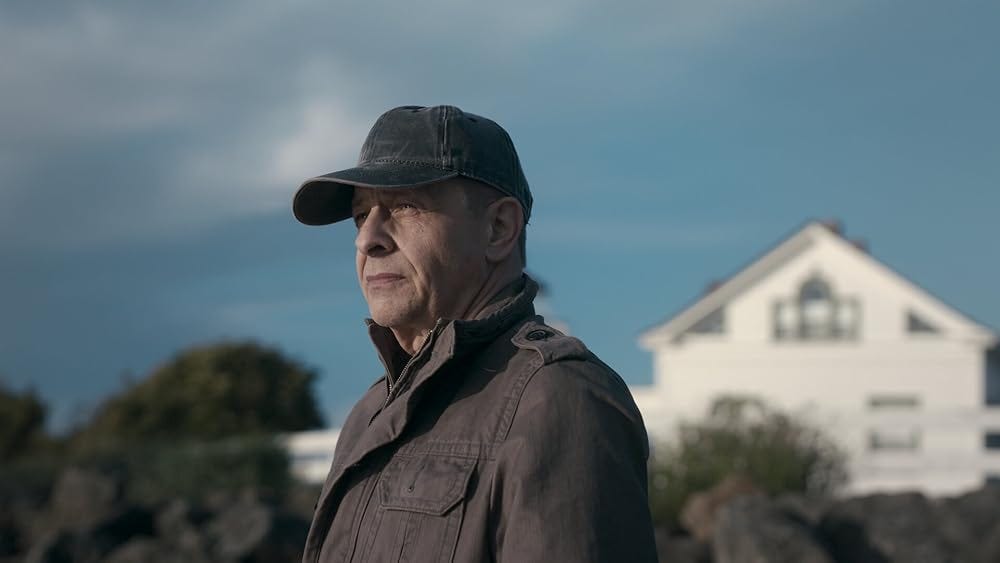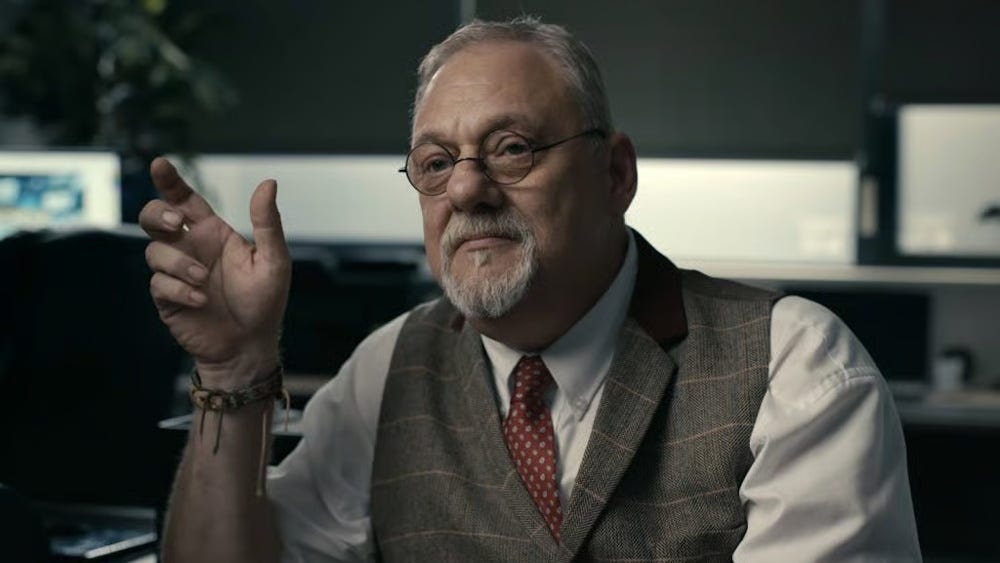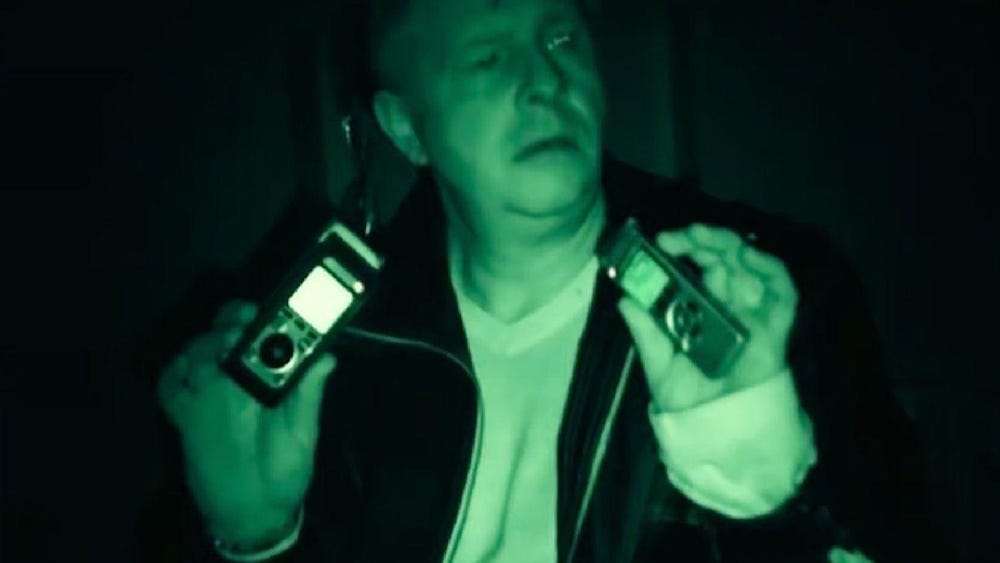This "Unsolved Mystery" Isn’t About the Ghosts
What Netflix left out of Don Phillips’ Unsolved Mysteries episode - from a writer who examined his work for over a decade.
When Don Phillips’ name was mentioned during promotion for Volume 5 of Unsolved Mysteries on Netflix, I didn’t have to Google him. Between 2011 and 2016 I wrote extensively about his work on my old blog, Hayley is a Ghost. Even back then, what he was doing never really felt like a story about ghosts so much as a story about ego: men desperate to be profound, building worlds in which only they can interpret hidden forces, and being rewarded by television producers who like a strong central character more than they like asking difficult questions.
The episode My Paranormal Partner (Vol. 5, Ep. 2) is, in many ways, a neat summary of that familiar dynamic. On the surface it’s about hauntings, grief, and comfort. Underneath, it’s about how easy it is to dress up one man’s narrative as an unsolved mystery, and how much gets flattened, ignored, or exploited along the way. Buckle in, folks…
The Haunting of Gaynor’s House
The story begins over a decade ago in a house in Leicester, owned by a woman called Gaynor. The set-up is instantly familiar - the family move in, objects start to go missing, and a child talks solemnly to an invisible friend but refuses to say who it is. Things then escalate with curtains catching fire and people being pushed at the top of the stairs.
Enter Don.
He says he arrived skeptical but almost immediately felt the energy of the place and sensed a female presence. He asks into the air, “What’s your name?” Later, viewers are played a recording in which a faint voice supposedly answers “Becky”. From that point, Becky is treated as a central character. She warns Don about a negative entity in the house, reassures him she’s dealt with it, and is essentially cast as his invisible sidekick who travels with him to help other haunted people.
That would already be quite a leap if it were clearly framed as one man’s personal belief but Unsolved Mysteries presents it as something closer to evidence. We’re told that Don has been able to “talk to the atmosphere, to the air, with the spirit people” since he was eight, and that his ears are tuned to their frequency. When he hears them, he captures their voices in real time on digital recorders, as if this somehow backs up his psychic claims.
We’re not asked to consider whether any of this is plausible, just invited to accept it as a starting point and move along.
Enter the Skeptic Sidekick
Recognising that “skeptics want evidence”, Don calls in a man presented as an open-minded skeptic - Steve Mera. Long-time readers of my work will recognise the name as I’ve written before about his unaccredited qualifications, questionable training courses, and a “scientific” report he co-authored that was later criticised for plagiarism and poor methodology. None of this makes it into the episode. On Netflix, he is simply the Serious Scientific Man who is cast as yet another supporting character orbiting Don.
Mera says he wants to see solid evidence to back Don’s claims up. Which is good, right? Only, the evidence he accepts leaves a lot to be desired. It includes Don standing in Gaynor’s house and impressing Steve with a live recording on a Dictaphone that both men take to be the phrase “my name is Becky”. Mera describes feeling a rush.
Mera then puts together an experiment in which he seals three images in envelopes. Don asks Becky what the picture shows, plays back the audio recording, and a fuzzy sound is interpreted as “it’s a kite”. The envelope is opened and the target image inside is indeed a kite.
As an audience, we’re nudged towards thinking ‘Wow. How could she have known?’ What we don’t see is any attempt to treat this as a test rather than a party trick. There’s no pre-registered list of targets, no visible pool of possible images, no decoys, no independent scoring of the audio by people who don’t know the right answers. We cut straight from set-up to reveal, with the messy bit in the middle blurred into mystery.
If Becky really can name the contents of envelopes, there are straightforward ways to find that out. You randomise the images and hide the target from everyone. You repeat the test enough times to see whether the hits are better than chance. Instead, we’re asked to treat one edited segment of television as proof that Don’s special spirit friend “got it right”.
A Paranormal Road Trip
Don and friends (both physical and invisible) soon hit the road, travelling to a series of spooky hotspots. At Cannock Chase, Don is presented as someone who can feel the residues of horror from the well-known Raymond Morris child murders in the area. We watch him follow an “energy” into the dark, hyperventilate a bit, and dramatically collapse while Steve tries to comfort him.
The implication is that he is brushing up against something tied to those real, brutal crimes and it’s hard to ignore how those murdered children are being used here - not as people whose deaths deserve quiet dignity, but as atmospheric backdrop for Don’s performance. It’s genuinely gross.
Later, at Tutbury Castle, a man called Chris Andrews appears with a bat detector, which he says can “modulate frequencies for EVP”. Bat detectors are designed to convert ultrasonic bat calls into audio humans can hear. In the show, the device is essentially repackaged as a spirit radio. Don announces that a spirit portal is forming and we’re told that the bat detector picks up what sounds like the word “portal”. Chris becomes emotional, the music swells, the camera lingers.
Electronic Voice Phenomena (EVP) are supposed spirit voices that appear on audio recordings but weren’t heard at the time by the people present. In practice, they’re usually faint noises or random sounds that humans then interpret as words - especially when they’re told in advance what they’re “meant” to hear.
At no point does anyone ask how you’d separate meaningful signal from random noise, or whether this is anything more than humans doing what humans always do with fuzz and static - hearing patterns that match whatever they’ve been primed to expect. Isn’t it somehow more plausible to suggest that Chris is hearing bats who can secretly talk through his bat detector as opposed to the idea it’s picking up the spirits of the dead? I jest, of course, but the ridiculousness of the notion put forward on the show cannot be understated…

Then comes a dowsing segment that could have been lifted from a 1970s VHS. Mera holds a pair of dowsing rods while Don stands in front of him, waving his hands around. The rods twitch and turn and the viewer is led to believe the idea that Don is moving them by somehow manipulating spirit energy - like a low-budget Jedi.
Nobody mentions the ideomotor effect - the well-established psychological phenomenon where people make small, unconscious movements that steer tools like dowsing rods and Ouija planchettes. Nor does anyone suggest attaching the rods to a rig so neither man can physically influence them, intentionally or otherwise. For someone framed as a scientific investigator, it’s a very revealing silence from Steve Mera.
And again, if Don genuinely could move dowsing rods at will with some kind of external force, that would be testable. You could blindfold participants, lock the rods, record everything, and invite outside observers to review the data. Instead, we get a single, theatrical moment.
Things Get a Little Bit Sinister…
The episode then hops to Ireland, where ghost-hunting TV star Barry Fitzgerald talks about a djinn haunting a site he shows Don and Steve. There’s no theological or cultural context - “djinn” here is just another sinister label, a different flavour of invisible being to make Don’s alleged abilities look more impressive. We’re now stacking one unexamined belief system on top of another and calling it investigation.
Earlier in the episode, Don has already provided a biography for his spirit guide, Becky - a 35-year-old teacher with two children who died in a train or plane crash in 1988. Barry explains that he went looking and could find no record of anyone matching that description. His conclusion, as the show presents it, is that Becky must have lied.
That is the level of scrutiny we get. Not maybe the details are wrong or maybe Don is elaborating. Not maybe the whole premise doesn’t stack up. Just… the ghost fibbed.
The story is protected, the ego maintained, and reality bent to fit around it.
By the end, the show has drifted fully into the language of demons and possession. Perhaps Becky isn’t Becky at all, she could be a demon, and maybe Don himself is possessed. These suggestions are delivered earnestly, with slow zooms on serious faces and heavy, thoughtful music. There is no hint that we might be watching anything other than one man’s untested beliefs being dramatised for television.
My Paranormal Partner offers viewers not an investigation but a performance. It legitimises possession, demons, djinn, portals, and ghosts as reasonable explanations for ordinary events, without any counterbalance. It drapes those ideas over real tragedies - including the murders of children - as if those lives exist mainly as spooky set pieces. And at the centre of it all, framed as a tortured-but-brave figure, is Don Phillips.
The Long Backstory
None of this came out of nowhere.
In the early 2010s, I was already looking closely at Don’s public work – his evidence, his methods, and the way he presented himself. The response, from him and his followers, was a wave of online hostility that will be familiar to anyone who has ever criticised a paranormal personality.
I wrote about his misuse of equipment on television and in online videos. For example, a clip that was played on morning television in the UK that showed him pointing an infrared thermometer at whatever surface happened to be nearby, watching the readout jump up and down, and insisting that the display showed cold spots created by spirits rather than simply different temperatures of different materials. The gadgetry looked impressive on screen; but the underlying method (if you can call it that) dissolved on contact with basic physics.
Ethically, there were serious red flags. In one instance, he publicly described visiting a cemetery and contacting the spirit of a named child who had died only a couple of years earlier, then inviting her to come home with him. He posted the story with enough detail that anyone local could have identified the child and her family. You don’t have to believe in ghosts to understand why that is indefensible.
Turning a dead child into a character in your personal haunting narrative, and broadcasting that without any apparent concern for the family’s feelings, crosses a line. If I had £1 for every time Don did some version of this I’d have at least £2, which isn’t a lot - but it’s still more than zero, and more than there should be.
The pattern, over and over, was that claims of research and science dissolved the moment you went looking for data, methods, or peer review. What remained constant was Don, who positioned himself as the linchpin of every story - the one who could sense the energies, who spirits followed home, and who was always in the right place to catch a dramatic piece of audio. Locations and tools came and went, but the indispensable constant was Don. When awkward questions arose - missing records, methodological criticisms, ethical concerns - the response was rarely to engage but to shift the goalposts, remove the material from the internet, or attack the critic.
Unsolved Mysteries hasn’t uncovered a new puzzle here. It has taken that existing pattern - the same methods, the same untested assertions, the same appetite for stitching other people’s grief and trauma into a personal mythology - and handed it a global platform. The men are older, the cameras nicer, but the core is unchanged.
The show doesn’t crack a single genuine mystery and the only energy it shows any evidence of is Main Character energy. Yikes.
Coming soon: Don’t miss the piece coming later this week in which I discuss the time in 2023 that I fled a 16th century manor house in terror. Make sure you’re subscribed so you don’t miss out!





